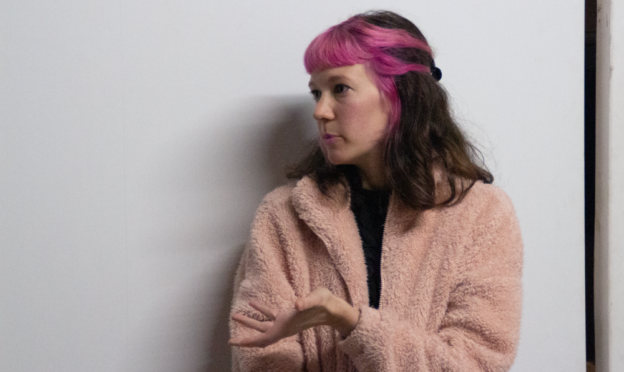The origins of photography include processes such as the cyanotype and bichromate gum: techniques which are highly toxic to the environment. Carmín Santos Posca recognizes the negative side effects of this practice and has dedicated part of her work to exploring the anthotype, a photo synthetic procedure that uses plant based pigmentation. Currently she is working mainly with coffee, red wine, spirulina, paprika, turmeric, and cabbage.
Carmín explains that the photosensitive solutions require different exposure times to uv light, ranging from a few hours to weeks. It is a process that involves exploration and new discoveries. The copies vary in color and even fade over time. Fading can be prevented by placing them in opaque containers. “I love this double agency of light: on the one hand it allows the creation of the image and on the other it erases it. This ephemeral dimension I find very interesting, as opposed to the saturation of images after the advent of digital photography. I associate it with memory and how quickly memories fade.”
The presence of art
Since her childhood, Carmín has been exposed to the art world. Her mom was an engraving and sculpture professor and presented her the world of museums and galleries. From her dad, she received a very valuable inheritance. ” When I was a teenager I found his Pentax MX and some lenses and began to experiment with analogue photography… It’s the camera I use to teach nowadays. As a matter of fact, last year I was able to digitalize a VHS recording of my third birthday. My dad was using the same Pentax to explain to someone how to open and close the diaphragm.”
images by PILOTENKUECHE or supplied by artist
Carmín believes that the use of technology has had an interesting impact on art. “It generates new knowledge that includes the contents of analogue media and also transcends these new forms of representation.” She has made use of this herself by creating the pedagogical project, virtual feminist museum. It is a directory of woman, lesbian, transvestite, trans and non-binary artists. “The idea is that it works as a free access tool for teachers to use in their classes. It came out because in all the years I had art history at school, I’d say 90 percent of the so-called geniuses were male.”
Carmín’s motivating forces
Carmín has a particular way of getting inspired. After coming home from her jobs as a professor and freelance designer, she unwinds, has dinner and watches a movie. Through these activities she gets ideas which she jots down and then through the week sees how she can organize them, put them together or form themes. She then searches and prints a mood board with pictures where she tries to associate to words, phrases or extract from books. She leaves it around her house and looks at it a few times while doing her regular activities. It is also important to her to get out and be part of what is happening around her, whether it be going to concerts, the cinema or friends’ exhibits.
Almodóvar, Fassbinder and Nan Goldin, are only a few of the many names that have influenced her and moved her deeply as an artist. Primarily because the three feature outsider characters. “One could say that they give a place to those who are marginalized by society. They also help to deactivate the heteronorm and the typical idea of a family. They build their own community.”
Hilma af Klint and Maria Sibylla Merian also play a role as those who have once fascinated her and continue to do so. Whilst uncovering their untold stories she learned that they did not achieve the recognition they deserved until many decades later just for being women.
Colonialism’s impact
Now at PILOTENKUECHE she is navigating the relationship between nature, culture and art through the juxtaposition of images and texts. In particular, she is exploring the link between women and nature mainly from the 15th century. She believes their role was merely as a backdrop to be observed (and arranged) by a spectator linked to the universal category of man in the Western paintings.
Above all, Carmín wishes to be remembered as the person who managed to get an anthotype done in the sunless German winter.
Written by Sarah Boada
You can keep up with Carmín at her website or catch up with her at one of our upcoming shows.
AMBIVALOVE
Vernissage 18 Feb 7-10 PM
Open Sun 19, Sat 25, Sun 26 Feb 4-8 PM
Geisserstr 75
04229 Leipzig
D.E.T.
Vernissage 18 March 7-10 PM
Open Sun 19 – Wed 22 Mar 4-8 PM
PILOTENKUECHE
Franz-Flemming-Str 9
04179 Leipzig





















